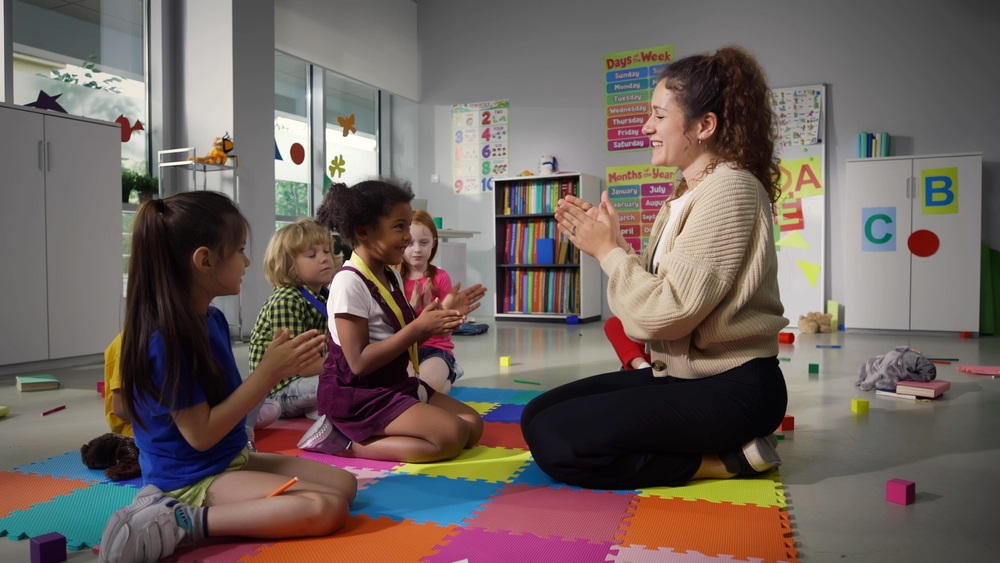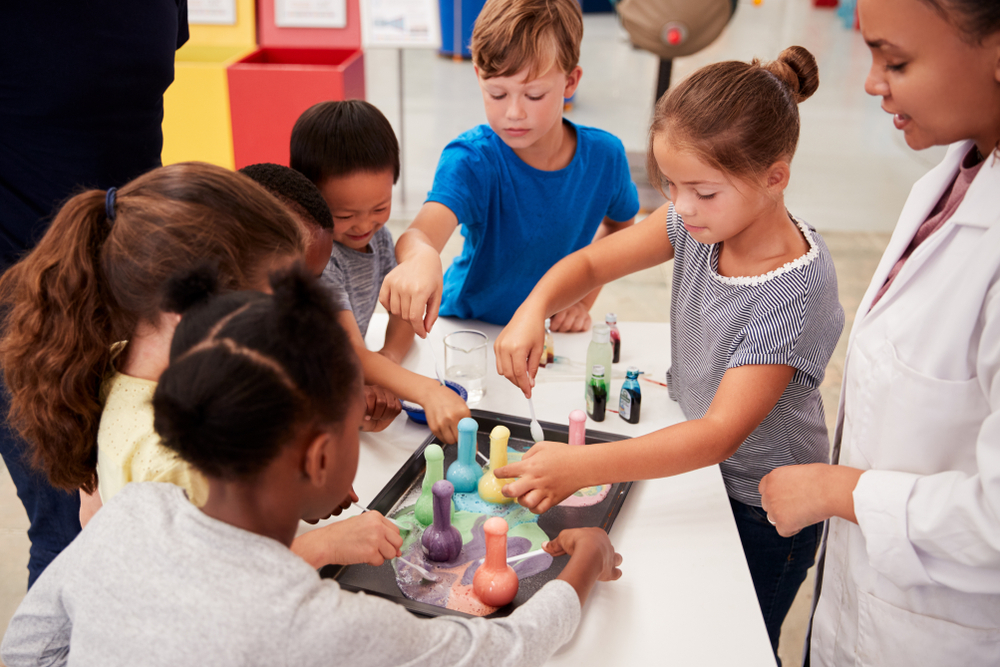
The emergent curriculum, a prominent figure in the evolving landscape of modern education, is revolutionizing the way we understand teaching and learning. This paradigm shift marks a significant departure from traditional, prescriptive teaching methods. It encourages a more collaborative approach, where the interests, ideas, and curiosity of children play a central role in shaping their educational journey.
The Pedagogical Power of the Emergent Curriculum
At its core, the emergent curriculum underscores the importance of learning as an organic, responsive process. This philosophy safeguards the natural curiosity of children, facilitating an environment where exploration and understanding are actively celebrated. The learning context becomes a fluid entity, changing and reshaping itself based on the ongoing interests, interactions, and input of the learners.
The Emergent Curriculum in the 21st Century Educational Framework
In our rapidly evolving 21st century society, the importance of the emergent curriculum in modern education cannot be understated. With the exponential growth of technology and increased emphasis on personalized learning, this approach provides a flexible framework that caters to the diverse needs, interests, and learning styles of each student. It does so by granting them the opportunity to actively participate in their learning process, fostering critical thinking, creativity, and problem-solving skills that are essential for their holistic development.
The Emergent Curriculum: A Catalyst for Student Engagement
One of the striking benefits of the emergent curriculum lies in its potential for enhancing student engagement. By basing the curricular activities around the students’ interests, we not only generate an increased enthusiasm for learning but also empower the students to take charge of their educational journey. This involvement results in a deeper understanding, fostering lifelong learning habits and a positive attitude towards education.
The Emergent Curriculum: An Evolving Tool in Modern Education
The emergent curriculum is an invaluable asset in the realm of modern education. As educators continue to search for effective ways to engage, inspire, and educate the learners of today, this model offers a solution that respects the uniqueness of every child and encourages a lifelong love of learning.
What is Emergent Curriculum?
The Emergent Curriculum, at its core, is a flexible and dynamic educational approach that often finds its roots in the Reggio Emilia philosophy of early childhood education, where emphasis is placed on learning through play and student-led activities. This methodology sees the curriculum evolve based on the interests, ideas, questions, and curiosity expressed by the children.
Unlike a traditional curriculum, which is planned and predetermined by teachers or educational institutions, an emergent curriculum brings forth the value of spontaneity and adaptability. It brings a fluid sense of structure, where topics and themes ’emerge’ from the children’s observations, actions, and interactions, allowing educators to weave educational objectives into organically occurring themes and interests. This teaching methodology ensures that children have an active role in shaping their learning experiences, thereby promoting self-confidence, independence, and a high degree of engagement.
An essential aspect of the emergent curriculum is the role of the teacher as a co-learner and facilitator. Instead of just leading the education process, educators in this scheme work alongside children, guiding their inquiries and providing resources, scaffolding knowledge, and enriching their curiosities.
Emergent Learning Relevance in Education
The relevance of the emergent curriculum in contemporary education is profoundly significant due to its student-centeredness, flexibility, and adaptability. With modern educational research putting more emphasis on personalized learning, this approach uniquely caters to developing an educational program that aligns with the individual needs, interests, and learning styles of each student.
- Promoting Active Learning: The emergent curriculum encourages children to take an active part in their learning process. This active participation contributes to fostering a sense of ownership and responsibility over their educational journeys, thereby promoting more profound insight, engagement, and absorption of knowledge.
- Fostering Critical Skills: By encouraging children to explore their interests and inquisitions, the emergent curriculum becomes a catalyst for developing critical life skills such as problem-solving, creativity, critical thinking, and decision-making.
- Acknowledging Individuality: The emergent curriculum cherishes and respects the uniqueness of every child. It values the individual interests and strengths of each learner, providing a personalized learning path that ensures equal opportunities for children with varied learning styles and paces.
- Responsive to the Ever-changing Technological Landscape: With technology advancing at an unprecedented pace, the emergent curriculum offers a flexible framework that can swiftly adapt and integrate new technological tools and digital resources into the learning process.
In sum, the emergent curriculum is both an instrument and a philosophy that fosters a love for learning and curiosity, equips students with critical skills, and provides a holistic, personalized, and dynamic education that aligns with the evolving societal needs. With its emphasis on student-led learning, it truly reflects the saying: “the curriculum is not the goal; the child is the goal.”

Emergent Curriculum in Preschool
The emergent curriculum’s significance in early childhood education cannot be overstated, particularly in the preschool setting. It’s during these crucial formative years that the emergent curriculum’s flexibility and adaptability show their real power, molding themselves according to the child’s pace, interests, and learning style.
Understanding the Role of Emergent Curriculum in Preschool Education
The emergent curriculum in preschool education plays several key roles:
- Nurturing Inherent Curiosity: Preschoolers are inherently curious, and this curiosity can be a powerful driver of learning if appropriately harnessed. The emergent curriculum does precisely this, promoting inquiry-based learning that feeds and nurtures this curiosity, leading to a deeper understanding of the world around them.
- Fostering Social Skills: As the emergent curriculum encourages children to express their ideas and engage in conversations, it indirectly fosters social skills. In a preschool setting, children learn to share, negotiate, and collaborate, laying the foundation for essential life skills.
- Encouraging Cognitive Development: The emergent curriculum’s hands-on, experiential methodology encourages cognitive development in preschoolers. The constant interplay of exploring, questioning, and discovering helps to enhance problem-solving skills and critical thinking.
- Respecting and Fostering Individual Learning Styles: Preschool is the perfect stage to identify and encourage individual learning styles. The emergent curriculum allows for this individuality to flourish by adapting to each child’s pace and style of learning.
- Developing Emotional Resilience: The emergent curriculum’s emphasis on the child’s interests and ideas encourages them to take risks in their learning. This can lead to fostering emotional resilience, as children learn to cope with challenges and setbacks in their educational journey.
Emergent Curriculum in Early Childhood Education
The Emergent Curriculum shines brightly in the domain of early childhood education. This approach provides a nurturing and flexible educational environment that acknowledges and respects the natural growth patterns of children.
Notable benefits of the emergent curriculum in early childhood education involve:
Child-Centered Learning: The emergent curriculum shifts the instructional approach from teacher-directed to child-led, creating a sense of ownership and engagement in their learning.
Development of Self-confidence: By giving children the freedom to explore, discover, and express themselves, the emergent curriculum helps to foster self-confidence and independence from an early age.
Exploration of Interests: Children are more likely to engage with their education when it involves their interests. The emergent curriculum leverages this by allowing the curriculum to ’emerge’ from the children’s interests and inquiries.
Enhanced Parental Involvement: The emergent curriculum encourages parents to participate actively in their child’s education. Parents’ insights into their child’s interests and strengths can significantly contribute to shaping the emergent curriculum.

Emergent Curriculum vs Traditional Approach
The emergent curriculum and traditional educational approaches situate themselves at opposite ends of the instructional spectrum. Here, we delve into a comprehensive comparison of the two, highlighting their inherent differences and the unique benefits each offers.
Traditional Educational Approach
A traditional educational approach is characterized by a predetermined, step-by-step curriculum that teachers follow rigorously. This approach is largely teacher-centered, operating under the belief that teachers should dictate the instructional process with little room for flexibility or student input.
Emergent Curriculum
Contrastingly, the emergent curriculum adopts a more dynamic, flexible, and student-centered learning model.
The Emergent Curriculum:
Fosters a learning environment where children’s interests, questions, and ideas shape their educational journey.
Emphasizes the process of learning rather than the end-product.
Values collaboration, fostering a classroom environment where teachers learn alongside students.
Provides a personalized, inclusive education accommodating a variety of learning styles and paces.
Uses varied and flexible assessment methods that measure a broad range of skills and competencies.
How Children’s Interests Shape the Learning Process
One of the defining characteristics of the emergent curriculum is its responsiveness to children’s interests in guiding the learning process.
Interest-driven learning is transformative, offering several key advantages:
Engagement and Motivation: When children engage with topics they are interested in, their motivation to learn naturally increases. This sustained attention often leads to profound understanding and mastery of the subject.
Development of Self-direction and Autonomy: Being able to follow their interests allows children to take charge of their learning, fostering a sense of responsibility, self-direction, and independence.
Promotion of Creativity and Critical Thinking: As children explore their interests, they tend to ask questions, seek solutions, and think creatively. This inquisitive attitude is instrumental in developing essential skills such as problem-solving and critical thinking.
Fostering of Positive Attitudes towards Learning: By associating learning with their interests, children develop positive attitudes and perceptions towards education, which can inspire lifelong learning.
Emergent Curriculum Examples in Action
The Emergent Curriculum approach is being utilized in a number of innovative ways across diverse educational settings. Here are some real-life examples of how this flexible and student-centered teaching methodology is being effectively applied:
Example 1: Learning Through Exploration in the Outdoors
A great example of the emergent curriculum in action can be observed in the nature-based outdoor education programs. For instance, in some schools, educators have transformed the traditional playground into a ‘natural play-scape’ filled with open-ended materials like mud, water, stones, and twigs. When children start engaging with these materials, their interests guide the direction of their learning.
For example, a child’s curiosity about stacking rocks to build a fortress can lead to a wide array of learning opportunities. This activity could trigger discussions about gravity, balance, and structure, effectively covering topics in physics. The child’s natural intrigue and experimentation become the basis of an evolving, comprehensive curriculum that is both authentic and engaging.
Example 2: An Emergent Announcement Board in a Preschool
In one preschool, the educators implemented an emergent curriculum by setting up a dynamic, collaborative announcement board. Post-its, pictures, and drawings were used by both children and educators to document their shared experiences, ideas, and learnings.
This board became a physical embodiment of the children’s interests, providing a clear visual of the evolving curriculum. It is a perfect example of how educators can organize an emergent curriculum around the learners’ experiences, stimulating their curiosity, and enhancing their involvement in the learning process.
Example 3: Incorporating Technology in an Emergent Curriculum
As our society becomes increasingly digitized, educators have found innovative ways to integrate technology within an emergent curriculum. For instance, there are classrooms where children’s interest in digital photography has been harnessed to create a project-based curriculum.
Children are encouraged to take pictures of things that interest them. The photographs are then used as a launching point for various exploratory activities – from writing stories about the captured images to studying the science behind how a camera works. In this way, the emergent curriculum can successfully bridge technology and education, embracing modern societal developments.
Example 4: Encouraging Cultural Exploration through Emergent Curriculum
In a multicultural kindergarten class, educators noticed the children’s fascination with the diverse backgrounds of their classmates. This observation led to the development of an emergent curriculum that encouraged students to explore various cultures.
Children were encouraged to share stories, traditions, and recipes from their cultures. This experience not only nurtured a respect for diversity but also allowed children to learn about geography, history, and sociology in a fun, engaging manner. It shows how an emergent curriculum can respond to the unique dynamics and interests within a classroom and create culturally responsive teaching methodologies.
These examples spotlight the adaptability and child-centric nature of the emergent curriculum. By tapping into children’s inherent curiosity, educators can craft engaging learning experiences that cater to individual interests and foster a love for learning.
The Emergent Curriculum Is dynamic, responsive, and child-centered approach might seem abstract without real-world examples to bring it into focus. Therefore, we offer several actual examples of this creative, flexible educational approach:
Nature Exploration Project
One of the most common starting points for an emergent curriculum is an exploration of the natural world. For instance, if children express consistent interest in the birds visiting their schoolyard, the teacher can orchestrate a project revolving around bird study. This inquiry could involve setting up bird feeders, observing different birds, researching various species, and even creating bird-related art projects. This emergent approach allows the incorporation of various educational objectives – biological knowledge, observational skills, artistic abilities – into a framework guided by the children’s interests.
Cultural Diversity Exploration
In multicultural classrooms, children’s diverse backgrounds can serve as a springboard for an emergent curriculum project. For example, if a child shares about a cultural festival he/she recently celebrated, it may spark curiosity among other kids. Capitalizing on this interest, the teacher can facilitate a multicultural project in which children learn about each other’s cultures, including family interviews, food tasting, folklore, traditional games, and so on. This project not only accumulates knowledge about world cultures but also fosters respect and understanding between different cultures.
Construction Project
This project emerges if multiple children show significant interest in building structures or machinery. This interest can evolve into a comprehensive construction project, with activities ranging from stacking blocks to learning about basic architectural concepts or even exploring the work of real-world engineers. This project could encompass mathematics, physics, teamwork, creativity, and problem-solving skills, grounded in the children’s genuine interest.
Community Helpers Project
Another example could stem from children’s curiosity about the people who help them in their daily lives, like firefighters, doctors, mail carriers, or police officers. Teachers can turn this interest into a community helpers project where children get to meet and interview these professionals, role-play their roles, and learn about their work’s importance to the community, thereby instilling social awareness and appreciation for the community’s helping hands.
These real-life examples showcase the emergent curriculum’s power to mold education around the interests, questions, and curiosity of the children. By facilitating a dynamic, flexible learning environment, this approach yields profound, engaging, and comprehensive learning experiences grounded in what truly matters to the children.
The Emergent Program
The Emergent Program forms a vital part of the modern educational framework, with its strong focus on putting the child at the center of the learning process. This divergent approach to education stands contrary to traditional, linear, and often rigid curriculums. It instead pivots around the fundamental principle that children are naturally curious, and their interests, ideas, and questions should shape their learning journey.
Understanding the Structure and Benefits of an Emergent Program
The Emergent Program can be best described as a fluid, flexible, and dynamic curriculum. It does not impose a predefined structure or case a set of predetermined learning objectives onto the students. Instead, it evolves based on the interests, inquiries, and observations expressed by the children themselves. The structure of the emergent program will, therefore, appear different in different classrooms, reflecting the unique mix of children’s interests, questions, and ideas.
While one class might be deeply engrossed in a project about the wildlife in their local area, another might be skillfully weaving a curriculum around the architecture and construction after a child in the group expressed an interest in how buildings are built. This adaptability is a defining feature of the Emergent Program.
The benefits of implementing an Emergent Program are manifold:
Child-centered: The Emergent Program respects and cherishes the uniqueness of every child. It gives children the driver’s seat in their educational journey, fostering a sense of ownership, responsibility, and self-confidence.
Enhances Engagement: Since the curriculum is shaped around their interests, children show greater engagement and enthusiasm for learning.
Fosters Critical Skills: The Emergent Program is a catalyst for developing vital skills such as problem-solving, creativity, critical thinking, and decision-making.
Cultivates Lifelong Learning Habits: The Emergent Program fosters a love for learning, curiosity, and the joy of discovery, equipping students with the mindset of lifelong learners.

Emergent Learning Center: A Practical Approach for Implementation
Implementing an Emergent Program can indeed be a daunting task, primarily because of its non-linear, dynamic, and child-centered nature.
Here, Emergent Learning Centers come into the picture as a practical solution.
Emergent Learning Centers operate on the principle that children should be provided with the resources and the environment that stimulate their curiosity and natural inclination to learn. Be it a Science corner that invites children to experiment and observe, a Literacy center that nurtures a love for words and stories, or an Art center that encourages creativity and self-expression, these centers act as catalysts for learning in an Emergent Program.
Facilitating an Emergent Learning Center involves:
Observing and Documenting: Pay close attention to children’s interactions, conversations, play, and their expressed interests. This documentation forms the backbone of an emergent curriculum.
Providing Resources: Based on these observations, provide materials and resources that stimulate and extend these interests.
Creating an Inviting Environment: Arrange these materials in a way that invites exploration and inquiry.
Giving Children Choice: Let children choose which center they want to explore and how they want to interact with the materials.
Taking the Role of a Guide: Be a co-learner alongside your students, guiding their inquiries, and scaffolding their learning.
Implementing the Emergent Program through Emergent Learning Centers promotes hands-on, experiential learning guided by the child’s interests and curiosity.
From The National Association for the Education of Young Children we learn that collaborative learning fosters an inclusive and respectful learning environment that acknowledges and cherishes the individuality of each child. When adopted in a classroom, Emergent Learning Centers can be a powerful tool for fostering a deep, comprehensive understanding while equipping learners with vital life skills.
Conclusion
The Emergent Curriculum is not just an educational model; it is a paradigm shift that is redefining the landscape of teaching and learning in the 21st century. By placing the child at the center of the learning scenario, it departs significantly from traditional teaching methods that were often rigid, prescriptive, and teacher-centered. The flexibility and responsiveness of the emergent curriculum have resonated with modern educational philosophies that call for a more personalized, inclusive, and engaging approach to education.
The Power and Potential of the Emergent Curriculum
The underlying strength of the Emergent Curriculum lies in its unique ability to harness the inherent curiosity, interests, and creativity of children, using these as the main driving forces behind their educational journey. By encouraging active participation, nurturing critical life skills, and cherishing the individuality of each learner, this approach has proven its mettle as a highly effective tool in fostering holistic development and lifelong love for learning.
Moreover, the emergence of technology in the educational scene has further underscored the relevance and utility of the Emergent Curriculum. Its adaptability and responsiveness have been instrumental in integrating new technological tools and digital resources into the classroom, thereby keeping pace with the rapid advancements in the digital world.
Future Prospects of the Emergent Curriculum
The Emergent Curriculum is far from being a static concept. As an evolving tool, it will continue to adapt and reshape itself in response to the ever-changing interests and needs of learners. It will also need to adapt to evolving societal dynamics, technological advancements, individual diversities, and shifting educational paradigms. The journey towards a comprehensive, fully-realized emergent curriculum continues, promising expected and unexpected breakthroughs in educational strategies and techniques.
Resources for Further Learning
For those interested in exploring the Emergent Curriculum in more depth, here are some resources that provide further learning opportunities:
- The Reggio Emila Approach: An Overview – Bailey Routledge – This resource provides a comprehensive overview of the Reggio Emilia approach, upon which much of the emergent curriculum is based.
- National Association for the Education of Young Children (NAEYC) – The NAEYC is a professional organization that offers a wealth of resources, articles, and research on child-centered education, including the emergent curriculum.
- Emergent Curriculum in Early Childhood Settings: From Theory to Practice – Susan Stacey – This book offers practical suggestions for implementing an emergent curriculum in early childhood settings. It features numerous stories from actual classrooms, dialogue from teachers, and activities that can be used to stimulate children’s learning.
- Early Childhood Education Journal – A peer-reviewed journal publishing significant papers that address the needs of children from birth through eight years of age in relation to their education and development.
- Child-Centered Curriculum | edX – A professional certificate program from edX that allows learners to delve into practical applications of child-centered curriculum.
Remember, the Emergent Curriculum is a journey, not a destination. It requires active engagement, continuous exploration, and a shared commitment from educators, parents, and children alike. As we delve deeper into the intricacies of this approach, we are bound to uncover fascinating possibilities and potentials that will shape the future of education.
FAQ’s
What are some examples of the emergent curriculum in action?
Examples of the emergent curriculum in action include exploratory outdoor education programs, dynamic announcement boards in preschools that document shared experiences, incorporating technology like digital photography into the curriculum, and developing unique learning experiences that encourage cultural exploration. Each of these examples is based on the interests and curiosities of the students, enhancing their engagement and promoting self-driven learning.
How can we define emergent learning?
Emergent learning is centered around the interests, ideas, and inquiries of the learners. Rather than a rigid, predetermined curriculum, emergent learning is dynamic, flexible, and student-led. The role of the teacher in this learning model is as a co-learner and facilitator, providing resources to guide children’s inquiries and extend their knowledge. This approach values spontaneity, adaptability, and allows the curriculum to evolve organically based on student interactions and observations.
What is the relevance of the emergent curriculum in preschool?
In a preschool setting, the emergent curriculum plays key roles such as nurturing inherent curiosity, fostering social skills, encouraging cognitive development, respecting individual learning styles, and developing emotional resilience. Preschoolers are naturally curious, and the emergent curriculum promotes inquiry-based learning that allows them to gain a deeper understanding of the world around them.
How is emergent curriculum defined?
The emergent curriculum is defined as an educational approach that centers around the interests, questions, and curiosities of the learners. Unlike traditional curricula, which are predetermined by teachers or educational institutions, the emergent curriculum is flexible, responsive, and dynamic, evolving based on children’s observations, interactions, and interests. This teaching methodology values spontaneity, adaptability and ensures that children play an active role in shaping their own learning experiences.
What is an emergent program?
An emergent program pivots around the principle that children are naturally curious and their interests, ideas, and questions should guide their learning journey. This program is characterized by its flexibility and dynamism, evolving based on children’s expressed interests and observations. The structure of an emergent program will differ in different classrooms, reflecting the unique mix of children’s interests and ideas.
How does the emergent curriculum operate in early childhood education?
The emergent curriculum is highly effective in the domain of early childhood education as it provides a nurturing and flexible educational environment that respects the natural growth patterns of children. Child-centered learning, development of self-confidence, exploration of interests, and enhanced parental involvement are some of the benefits that the emergent curriculum brings to early childhood education.

 Español
Español